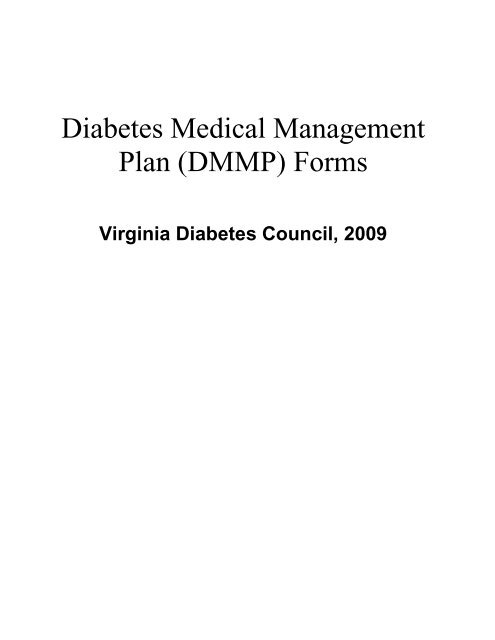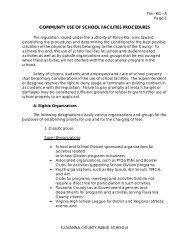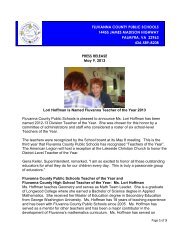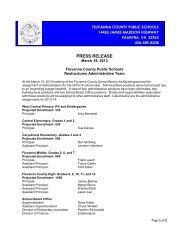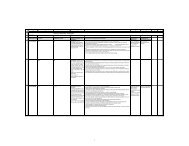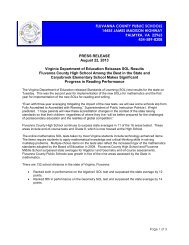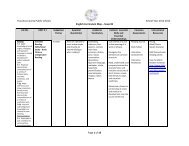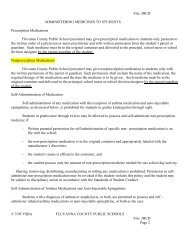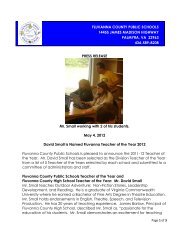Diabetes Medical Management Plan (DMMP) Forms
Diabetes Medical Management Plan (DMMP) Forms
Diabetes Medical Management Plan (DMMP) Forms
Create successful ePaper yourself
Turn your PDF publications into a flip-book with our unique Google optimized e-Paper software.
<strong>Diabetes</strong> <strong>Medical</strong> <strong>Management</strong><strong>Plan</strong> (<strong>DMMP</strong>) <strong>Forms</strong>Virginia <strong>Diabetes</strong> Council, 2009
Virginia <strong>Diabetes</strong> <strong>Medical</strong> <strong>Management</strong> <strong>Plan</strong>Pediatric Endocrinology practices from across the state of Virginia have collaborated todevelop, trial, evaluate and revise four forms for statewide use in assisting with the care ofchildren with diabetes in the schools. These forms are intended to be used in conjunctionwith the Virginia <strong>Diabetes</strong> Care Practice and Protocol and do not include instructions relatedto basic accommodations and care which is to be expected for any child with diabetes.These forms are available for use by any school, or healthcare provider in the state ofVirginia. The forms have been developed to be used as electronic forms which can becompleted in Microsoft Word and then printed, scanned and/or saved; making them simpleto archive and to alter when changes are required. A separate set of the forms has alsobeen created for use in instances where computer access is limited or not feasible. Themajority of children will need Part 1 completed as a part of their annual school enrollmentand check-in with the school health clinic and Part 2 is to be completed by their healthcareprovider. Part 3 and Part 4 will only be used as necessary for those wearing insulin pumpsand those who are competent & accountable for self-carry privileges. Individual providersare encouraged to customize the forms to include their contact information, phone numbers,etc. It is requested that the format remain consistent so that complete information can beprovided to the school health clinic personnel in a standardized manner to assure safetyand the highest quality care possible for the student with diabetes.The Virginia <strong>Diabetes</strong> Council has endorsed these forms and the Department of Education,Office of Student Services supports their use in all school systems in Virginia.A. Part 1. Contact Information and <strong>Diabetes</strong> <strong>Medical</strong> HistoryThis form is distributed by the school nurse/clinic and is to be completed by the parentor guardian. The information in this form provides helpful information for completingthe Individualized Health <strong>Plan</strong>. This form is required by the State of Virginia Board ofEducation as required by law to determine parent/guardian permission or denial ofpermission for administration of insulin and/or glucagon by trained unlicensedpersonnel. This form does not require any involvement from the healthcare provider’soffice. This two page form should be available in the school clinic prior to thebeginning of the school year and distributed to caregivers of students with knowndiabetes at registration, orientation or other meeting between the nurse and caregiver.The form should be completed annually or upon new diagnosis of diabetes.B. Part 2. <strong>Diabetes</strong> <strong>Medical</strong> <strong>Management</strong> <strong>Plan</strong> (<strong>DMMP</strong>).Physician Orders and AuthorizationsChildren with diabetes receiving care at most of the pediatric endocrinology healthcareproviders’ clinics/offices in Virginia have agreed to use the forms included in thisdocument. They may complete the forms electronically, in writing or a combination of2
oth. Parents/guardians should request or obtain these completed forms from theirphysician and are required to sign these forms to authorize communication betweenthe healthcare provider’s office and the school. School forms will not automatically besent to the school without the parent/guardian’s request. The forms should then bebrought to the school by the child’s parent/guardian. If another physician’s officeprefers to use his/her own <strong>Diabetes</strong> <strong>Medical</strong> <strong>Management</strong> <strong>Plan</strong> it must include all ofthe elements in this form. Copies of these forms may be shared electronically or byprinting with any healthcare provider or family. These materials can also be accessedat the following websites:Virginia <strong>Diabetes</strong> CouncilVirginia Department of Educationwww.virginiadiabetes.orghttp://www.doe.virginia.gov/VDOE/Instruction/Health/home.html<strong>Forms</strong> may be individualized to a specific institution and may be adjusted to reflectpractice patterns of specific providers. Please note that physician authorization fortreatment by trained school designees must be included in the <strong>Diabetes</strong> <strong>Medical</strong><strong>Management</strong> <strong>Plan</strong> or a separate form must be provided. Healthcare providers andcaregivers should be aware that schools can refuse to provide <strong>Diabetes</strong> <strong>Medical</strong><strong>Management</strong> if proper orders are not on file at the school clinic. Use of prescriptionmedications and equipment by nurses requires orders from a provider licensed in theCommonwealth of Virginia (this includes physicians, nurse practitioners and physicianassistants). Providers may make changes to these orders during the school year andare required to send only the applicable page requiring changes (the entire order set isnot required). A <strong>DMMP</strong> should be completed at the beginning of each school year orupon new diagnosis of diabetes.C. Part 3. <strong>Plan</strong> Supplement for Student Wearing Insulin PumpIf the child wears an insulin pump, this supplemental form should be completed by thephysician and parent/guardian. Portions of this form will be completed by theparent/guardian after the healthcare provider initiates the sections requiring orders.This form has been developed to help provide information regarding the child’sproficiency in operating their insulin pump and to provide information on areas ofoperation where they will require assistance or supervision. Parents/guardians arerequired to provide adequate instruction, manuals and supplies to support pumptherapy use in the school.D. Part 4. Permission to Self-CarryIf a child is going to carry and self administer insulin and perform blood glucose checksin the classroom; an “Authorization to Carry and Self-Administer Medication Form” isrecommended and should be completed by the physician, school nurse and theparent/guardian. As explained on the form, the school has the option to revoke thisprivilege if adherence to school rules or guidelines is not demonstrated by the student.This form is not required by law, but serves to inform everyone of expectations andresponsibilities.3
E. Instructions for Use and Modification of Electronic <strong>DMMP</strong>The electronic version of the <strong>DMMP</strong> was formatted using Word in a Windowsenvironment. Conversion to a PDF format will be attempted in the future. Practicesare encouraged to individualize and personalize these forms to meet the needs of theirorganization and practice patterns. There may be items which you prefer to have asstandard selections versus drop-down choices; and you are encouraged to makethese modifications to ease completion of the forms. For example, if you always use70 mg/dL as your blood glucose level for hypoglycemia, delete the drop-down field andtype in the value you always use so that you have less drop-downs to complete. If youwant to add another choice to the drop-downs, you may also personalize these lists toreflect your practice patterns. If you don’t use Exercise/PE Carb Ratios, you can setthe Not Applicable check box to always be checked or you can delete the contents ofthis box on the form.When using the electronic forms, you are encouraged to create folders to save eachstudent’s forms to facilitate future changes. Children’s Hospital of The King’sDaughters (CHKD) has access to these forms on the organization’s network tofacilitate access from any networked computer in the system. This allows changes tobe made at the time of clinic visits at various locations, from the provider’s desktopduring telephone conversations and from computers on the inpatient units duringadmissions. This allows forms to easily be faxed or emailed as needed. A multiphysicianpractice should consider creating folders for each physician unless studentsare seen by multiple providers. Experience has taught users that your practice shouldsave a password protected version of your personalized form so that you always havean original uncompleted form saved. It is recommended that you always startcompleting an “empty” form so that you will be assured of not missing providingpersonalized orders for each student. A standardized nomenclature is recommendedfor saving each student’s form to ease access. This system will depend on whetheryou use names or medical record numbers to access patient files (keep in mind thatyou will not know the medical record number during telephone conversations).Consider one the following:LastnamefirstnamebirthdateLastnamefirstnamemedicalrecord#smithsusan01012000jonesjohn999999994
F. Instructions for Use of Microsoft Word Formatting FeaturesThe electronic forms have been created using the formatting features in MicrosoftWord. To activate the forms follow these steps:1. Click on view on the Toolbar.2. Select Toolbar.3. Put a check next to forms (this will add the forms Toolbar).4. You will see an icon that looks like a padlock at the right end of the formsToolbar.5. If it is gray you are in edit mode (you can make changes to the drop downs andedit the form in this mode).6. If the padlock icon is highlighted, you have activated the form for completion asa fillable form. In this mode fillable fields and dropdowns are activated. Youwill be able to use the tab key or your mouse to get to each item that needsto be completed (this will help to assure that every option has beencompleted).The forms have been designed to auto date every time they are opened to assure thatyou will always know the version you have opened and to make sure that every pageis dated for the school clinic. Tabbing through the forms will guarantee that you havecompleted the student’s name on every page of the forms.If you are a part of a single physician practice, you will want to delete the drop downoptions and add your printed name and credentials next to the signature section oneach page to simplify use of your forms. The version included has been personalizedto the CHKD practice for illustration purposes and these providers should be deletedfrom your list.After using the forms, you will find that there are boxes that you always check (forexample ordering Glucagon for all of your intensive therapy students). When in editmode, double click on the box and you will see an option for “not checked” or“checked” which you can customize to your preferred practice pattern.5
Virginia School <strong>Diabetes</strong> <strong>Medical</strong> <strong>Management</strong> <strong>Forms</strong>Student ___________________________School ____________________ Effective Date _______________Date of Birth ________________ Grade __________ Homeroom Teacher ____________________________Instructions:1. Part 1- Contact Information and <strong>Diabetes</strong> <strong>Medical</strong> History. To be completed by parent/guardianand returned to school nurse (prior to beginning of each school year or upon diagnosis).►Includes: Parent authorization for trained school designees to administer insulin and/or glucagon (required by VirginiaLaw).2. Part 2*- <strong>Diabetes</strong> <strong>Medical</strong> <strong>Management</strong> <strong>Plan</strong> (<strong>DMMP</strong>). Student’s physician/provider to completeIntensive Therapy or Conventional Therapy/Type 2 version of <strong>DMMP</strong>.Please note that physician authorization for treatment by trained school designees must be included in the <strong>Diabetes</strong> <strong>Medical</strong><strong>Management</strong> <strong>Plan</strong> or a separate form must be provided.3. Part 3*- Insulin Pump Supplement. Have the physician/provider, diabetes educator, andparent/guardian collaborate to complete appropriate portions if your child wears an insulin pump.4. Part 4- Permission to Self-Carry and Self-Administer <strong>Diabetes</strong> Care. To be completed by thephysician/provider, school nurse and the parent/guardian if your child is going to carry and selfadminister insulin and/or perform blood glucose checks in the classroom.5. Virginia <strong>Diabetes</strong> Council School <strong>Diabetes</strong> Care Practice and Protocol provides guidelines,accepted accommodations and references applicable to all students with diabetes. This document isavailable from your school nurse, the Department of Education Office of Student Services, or the Virginia <strong>Diabetes</strong> Council.*Other <strong>Diabetes</strong> <strong>Medical</strong> <strong>Management</strong> <strong>Plan</strong>s may be used for Parts 2, 3 & 4 as long as all components are represented.Return completed forms to the school nurse as quickly as possible. Thank you for your cooperation.School nurse___________________________________ Phone______________ Date______________Part 1: Contact Information and <strong>Diabetes</strong> <strong>Medical</strong> History Page 1 of 2To be completed by Parent/Guardian:Parent/Guardian #1:___________________________________________________________________Address: ______________________________________________________________________________Telephone-Home: _______________________Work: ________________ Cell: ______________________Parent/Guardian #2:___________________________________________________________________Address: ______________________________________________________________________________Telephone-Home: _______________________Work: ________________ Cell: ______________________Other emergency contact: _____________________________________________________________Address: _____________________________________________ Relationship: ______________________Telephone-Home: _______________________Work: _________________ Cell: _____________________Physician managing diabetes: _________________________________________________________Address: _____________________________________________________________________________Main Office #_________________ Fax #_________________ Emergency Phone #___________________Nurse/<strong>Diabetes</strong> Educator: _________________________________________ Office # ___________________6
Page 2 of 2Student:<strong>Medical</strong> HistoryParent/Guardian Response (check appropriate boxes and complete blanks)Diagnosis information At what age? Type of diabetes?How often is child seen bydiabetes physician?Frequency:Date of last visit:Nutritional needs Snacks ____AM ____PM _____Prior to Exercise/Activity Only in case of low blood glucose Student may determine if CHO counting In the event of a class party may eat the treat (include insulin coverage ifindicated in medical orders) student able to determine whether to eat the treat replace with parent supplied treat may NOT eat the treat Other ___________________________________________________________Child’s most commonsigns of low blood glucoseHow often does childexperience low bloodglucose and how severe?Episode(s) of ketoacidosisField tripsSerious illness, injuries orhospitalizations this pastyearList any other medicationscurrently being takenAllergies (include foods,medications, etc):Other concerns andcomments trembling tingling loss of coordination dizziness moist skin/sweating slurred speech heart pounding hunger confusion weakness fatigue seizure pale skin headache unconsciousness change in mood or behavior other _________________________________Mild/Moderate once a day once a week once a monthIndicate date(s) of last mild/moderate episode(s) ______________________________What time of day is most common for hypoglycemia to occur? ___________________Severe (i.e. unconscious, unable to swallow, seizure, or needed Glucagon)Include date(s) of recent episode(s) ______________________________________Include date(s) of recent episode(s)Parent/guardian will accompany child during field trips? YES NO Yes, if availableDate(s) and describeI give permission to the school nurse and designated school personnel*, who have been trained and are under thesupervision of the school nurse to perform and carry out the diabetes care tasks as outlined in my child’s <strong>Diabetes</strong><strong>Medical</strong> <strong>Management</strong> <strong>Plan</strong> as ordered by the physician. I give permission to the designated school personnel, whohave been trained to perform the following diabetes care tasks for my child. (Code of Virginia§ 22.1-274).Insulin Administration YES NO Glucagon Administration YES NOI understand that I am to provide all supplies to the school necessary for the treatment of my child’s diabetes. I alsoconsent to the release of information contained in the <strong>Diabetes</strong> <strong>Medical</strong> <strong>Management</strong> <strong>Plan</strong> to staff members and otheradults who have custodial care of my child and who may need to know this information to maintain my child’s healthand safety. I also give permission to contact the above named physician and members of the diabetes managementteam regarding my child’s diabetes should the need arise.Parent/Guardian Name _____________________________________________ Date ________________Parent/Guardian Signature_____________________________________________________________________School Nurse’s Name ______________________________________________ Date ________________School Nurse’s Signature _____________________________________________________________________*Note: If at any time you would like to have the names of the designated school personnel that have been trained, please contactthe school nurse. Names and training records are kept in the school clinic.7
Name of InstitutionInstitution AddressDepartmentDIABETES MEDICAL MANAGEMENT PLANINTENSIVE THERAPYPage 1 of 3Part 2: Virginia <strong>Diabetes</strong> <strong>Medical</strong> <strong>Management</strong> <strong>Plan</strong> (<strong>DMMP</strong>)To be completed by physician/provider.Patient Label or MRN, Acct#, Patient Name, DOB, Date of ServiceNotice to Parents: Medication(s) MUST be brought to school by the PARENT/GUARDIAN in a container that is appropriately labeledby the pharmacy or physician/practitioner.In order for schools to safely administer medication during school hours, the following regulations should be observed:‣ A new copy of the <strong>DMMP</strong> must be completed at the beginning of each school year. This form, an Authorization forMedication Administration form, or MD prescription must be received in order to change diabetes care at school during theschool year.Student Name (Last, First, MI)Student’s Date of BirthSchool Student’s Grade Home PhoneParent NameWork/Cell PhoneHome Address City State, Zip codeStudent’s Diagnosis: DIABETES: Type 1 Type 2OtherToday’s Date8/19/2011BLOOD GLUCOSE (BG)MONITORING with meter, lancets,lancing device, and test stripsYesMONITORINGNoStudent requires supervisionTo be performed by schoolpersonnelStudent is independentPermission to self-carryBefore mealsFor symptoms of hypo/hyperglycemia &anytime the student does not feel wellBefore PE/ActivityAfter PE/ActivityPrior to dismissalAdditional BG monitoring may be performedat parent’s requestCONTINUOUS GLUCOSEMONITORING (CGM)Brand/Model:YesAlarms set for:NoLow:_____ (mg/dL)High:_____ (mg/dL)Always confirm CGM results with finger stickcheck before taking action on sensor bloodglucose level. If student has symptoms or signsof hypoglycemia, check finger stick bloodglucose level regardless of CGM.URINE KETONE TESTINGBLOOD KETONE TESTINGAnytime the BG >mg/dL or when student complains of nausea, vomiting,abdominal pain. See page 3 for further instructions under hyperglycemiamanagement.NAME OF MEDICATION DOSE/ROUTE TIMEGLUCAGON - INJECTABLEGlucophage ® (Metformin)to be administered at schoolOther:to be administered at schoolAdditional Instructions:®0.5 mg subq/IM1.0 mg subq/IMDOSAGEmg poTIMEAM or PMImmediately for severe hypoglycemia:unconscious, semi-conscious (unable tocontrol his/her airway or unable to swallow),or seizingPOSSIBLE SIDEEFFECTSNausea/vomiting,diarrheaTREATMENTOFSIDEEFFECTSClear liquidsSpecific duration of order:2009-2010SCHOOL YEARInstitution Form #Physician/Provider Signature: Provider Printed Name: Office Phone: XXX-XXX-XXXXOffice Fax: XXX-XXX-XXXXEmergency # XXX-XXX-XXXX8
Name of InstitutionInstitution AddressDEPARTMENTDIABETES MEDICAL MANAGEMENT PLANINTENSIVE THERAPYPage 2 of 3Patient Label or MRN, Acct#, Patient name, DOB, Date of ServiceSCHOOL YEAR 2009-2010 DIABETES SCHOOL CARE PLAN Student:Intensive Therapy/Multiple Daily Injections Effective date: 8/19/2011DefinitionsInsulin-to-Carbohydrate Ratio(CHO Ratio) the amount of insulin necessary toprevent hyperglycemia after ingestion ofa specified amount of carbohydrateInsulin Sensitivity(Correction Factor) the predicted drop in blood glucoseconcentration after administration of 1 unit ofregular or rapid-acting insulinTarget Blood Glucose a specific blood glucose value used todetermine the correction dose ofinsulin administered with a meal usually expressed as “1 unit for every____ grams of carbohydrate” usually expressed as “1 unit for every____mg/dl blood glucose is > target”INSULINInsulin to be given during school hours: Yes No May calculate/give own injections with supervision®Rapid-acting Insulin Type:Timing of Insulin Dose:(all doses to be administered subcutaneously)Rapid-acting Insulin should always be given prior tomeals snacks®_____units at _____am or pmif CHO intake can be predetermined.may mix with rapid-acting insulin‣ If CHO intake cannot be predetermined insulin should be given no(all doses to be administered subcutaneously)more than 30 minutes after completion of meal/snack.‣ Treat hypoglycemia before administration of meal or snack insulin.CALCULATING INSULIN DOSES: According to CHO ratio and Insulin Sensitivity/Correction Factor (if needed) - the student requires meal timecoverage with rapid-acting insulin based on the amount of carbohydrates in the meal and may require additional insulin to correct blood glucoseto the desired range according to the following formula:Insulin Dose = [(Actual BG – Target pre-meal BG) divided by Insulin Sensitivity] + [# carbohydrates consumed/CHO Ratio] Fractional amounts of insulin from correction and carbohydrate calculation, when added together, may yield an even amount of insulin If uneven, then round to the nearest half or whole unit (May use clinical discretion; if physical activity follows meal, then may round down).Target pre-meal BG:CHO Ratio:mg/dLParent has permissionto adjust CHO ratio in arange from1: to 1:Insulin Sensitivity/Correction Factor:unit for every > targetExercise/PE CHO Ratio:Not Applicable Less insulin may be required with meals prior to physical activity inorder to prevent hypoglycemia. If so, the Exercise/PE CHO Ratioshould be used instead of the CHO Ratio.Correction insulin to be administered for elevated blood glucose if 3 hours or more after last insulin doseSnacks In general, children with diabetes managed using Intensive Therapy/MDI do not require snacks. Scheduled snacks may be required prior to or after exercise in order to prevent hypoglycemia. Insulin is not administered with these snacks.Before ExerciseAfter Exercise Foods may be eaten at unscheduled times. Insulin may be ordered for these snacks in order to prevent post-meal hyperglycemia (see above). Snack time insulin = # carbohydrates consumed/CHO Ratio. Never provide insulin coverage for carbohydrate/glucose being used to treat hypoglycemia.Exercise and Sports In general, there are no restrictions on activity unless specifically noted. A student should not exercise if his/her blood glucose is < mg/dL or > 300 mg/dL (with positive ketones) immediately prior to exercise oruntil hypoglycemia/hyperglycemia is resolved. A source of fast-acting glucose & glucagon should be available in case of hypoglycemia.Specific duration of order:2009-2010SCHOOL YEARPhysician/Provider Signature: Provider Printed Name: Office Phone: xxx-xxx-xxxxOffice Fax: xxx-xxx-xxxxEmergency # xxx-xxx-xxxxInstitution Form #9
NAME OF INSTITUTIONInstitution AddressDEPARTMENTDIABETES MEDICAL MANAGEMENT PLANINTENSIVE THERAPYPage 3 of 3Patient Label or MRN, Acct#, Patient name, DOB, Date of ServiceSCHOOL YEAR 2009-2010 DIABETES SCHOOL CARE PLANHypoglycemia (Low Blood Glucose)Hypoglycemia is defined as a blood glucose 70 mg/dL despite fast-acting glucose sources, call xxx-xxx-xxxx.Hyperglycemia (High Blood Glucose)Signs of hyperglycemia: If hyperglycemia is suspected, check the blood glucose level.Hyperglycemia<strong>Management</strong>(High Blood Glucose)If BG > 300 mg/dL, or when child complains of nausea, vomiting, and/or abdominal pain,ask the student to check his/her urine for ketones If urine ketones are trace to small (blood ketones 0 - 1.0 mmol/L), give 8-16 ounces of sugar-free fluid(water), return to classroom If correction insulin has not been administered within 3 hours, provide correction insulin according tostudent’s Correction Factor and Target pre-meal BG Recheck BG and ketones 2 hours after administering insulin If urine ketones are moderate/large (blood ketones >1.0 mmol/L), give 8-16 ounces of sugar-free fluid(water) and call xxx-xxx-xxxx for instructions concerning insulin administration. Contact the Parent/Legal Guardian. Recheck BG and ketones 2 hours after administering insulinMy signature below provides authorization for the above written orders. I/We understand that all treatments and procedures may be performedby the school nurse, the student and / or trained unlicensed designated school personnel under the training and supervision provided by theschool nurse (or by EMS in the event of loss of consciousness or seizure) in accordance with state laws & regulations. I also give permission forthe school to contact the health care provider regarding these orders and administration of these medications.School plan ordered by:Acknowledged and received by:Physician/ProviderSignature:Parent/Legal Guardian:Provider Printed Name:Date:8/19/2011Date:Acknowledged and received by: School Representative: Date:Institution Form #Extreme thirst Frequent urination Blurry Vision Hunger HeadacheNausea Hyperactivity Dry Skin Dizziness Stomach ache10
INSTITUTION NAMEInstitution AddressDEPARTMENTDIABETES MEDICAL MANAGEMENT PLANCONVENTIONAL THERAPY or TYPE 2Page 1 of 3Patient Label or MRN, Acct#, Patient name, DOB, Date of ServicePart 2: Virginia <strong>Diabetes</strong> <strong>Medical</strong> <strong>Management</strong> <strong>Plan</strong> (<strong>DMMP</strong>)To be completed by physician/provider.Notice to Parents: Medication(s) MUST be brought to school by the PARENT/GUARDIAN in a container that is appropriately labeledby the pharmacy or physician/practitioner.In order for schools to safely administer medication during school hours, the following guidelines should be observed:‣ A new copy of the <strong>DMMP</strong> must be completed at the beginning of each school year. This form, an Authorization forMedication Administration form, or MD prescription must be received in order to change diabetes care at school during theschool year.Student Name (Last, First, MI)Student’s Date of BirthSchool Student’s Grade: Home PhoneParent NameWork/Cell PhoneHome Address City State, Zip codeStudent’s Diagnosis: DIABETES: Type 1 Type 2OtherToday’s Date8/19/2011BLOOD GLUCOSE (BG)MONITORING with meter, lancets,lancing device, and test stripsYesMONITORINGNoStudent requires supervisionTo be performed by school personnelStudent is independentPermission to self-carryBefore mealsFor symptoms of hypo/hyperglycemia &anytime the student does not feel wellBefore PE/ActivityAfter PE/ActivityPrior to dismissalAdditional BG monitoring may be performed atparent’s requestCONTINUOUS GLUCOSEMONITORING (CGM)Brand/Model:YesAlarms set for:NoLow:_____ (mg/dL)High:_____ (mg/dL)Always confirm CGM results with finger stickcheck before taking action on sensor bloodglucose level. If student has symptoms or signsof hypoglycemia, check finger stick bloodglucose level regardless of CGM.Anytime the BG > mg/dL or when student complains of nausea, vomiting,URINE KETONE TESTINGabdominal pain. See page 3 for further instructions under hyperglycemiaBLOOD KETONE TESTINGmanagement.NAME OF MEDICATION DOSE/ROUTE TIMEImmediately for severe hypoglycemia:0.5 mg subq/IMunconscious, semi-conscious (unable toGLUCAGON - INJECTABLE1.0 mg subq/IMcontrol his/her airway or unable to swallow),or seizingORAL MEDICATIONS DOSAGE TIMEGlucophage ® (Metformin)to be administered at schoolmg poAM or PMOther:®to be administered at schoolAdditional Instructions:POSSIBLE SIDEEFFECTSNausea/vomiting,diarrheaTREATMENT SIDEEFFECTSClear liquidsSpecific duration of order:2009-2010SCHOOL YEARInstitution Form #Physician/Provider Signature: Provider Printed Name: Office Phone: xxx-xxx-xxxxOffice Fax: xxx-xxx-xxxxEmergency # xxx-xxx-xxxx11
INSTITUTION NAMEInstitution AddressDEPARTMENTDIABETES MEDICAL MANAGEMENT PLANCONVENTIONAL THERAPY or TYPE 2Page 2 of 3Patient Label or MRN, Acct#, Patient name, DOB, Date of ServiceSCHOOL YEAR 2009-2010 DIABETES SCHOOL CARE PLAN Student:CONVENTIONAL THERAPY OR TYPE 2 DIABETES Effective date: 8/19/2011INSULINInsulin to be given during school hours: Yes No Student can administer insulin if supervisedInsulin Types:Rapid-acting Insulin Type:®Meal <strong>Plan</strong>:according to the following distribution:Short-acting Insulin Type: RegularBreakfast: gramsIntermediate-acting Insulin Type: NPHmay mix with rapid or short-acting insulinLong-acting Insulin Type:®units atmay mix with rapid-acting insulinam or pm(all doses to be administered subcutaneously)AM Snack:Lunch:PM Snack:gramsgramsgramsInsulin:CHO Ratio: 1 unit for every grams of CHOdecrease by 1 unit if pre-lunch reading is less than 80 mg/dL or ifstrenuous exercise if anticipated.Pre-breakfast dose: Regular units Humalog® or Novolog® or Apidra® units NPH unitsPre-lunch dose: Regular units Humalog® or Novolog® or Apidra® units NPH unitsPre-dinner dose: Regular units Humalog® or Novolog® or Apidra® units NPH unitsSliding scale to be administered at (times)If blood glucoseUnits of rapid-acting Insulin subq____________________ give ___________________________________________ give ___________________________________________ give ___________________________________________ give ___________________________________________ give ___________________________________________ give _______________________Insulin Sensitivity (Correction Factor) to beadministered at (times) the predicted drop in blood glucose concentration afteradministration of 1 unit of regular or rapid-acting insulin usually expressed as “1 unit for every ____mg/dl blood glucose is> target” If uneven, then round to the nearest half or whole unit (May useclinical discretion; if physical activity follows meal, then may rounddown)Sensitivity:Target:Other Instructions:Snacks Children using NPH insulin usually require snacks without additional insulin coverage (please, adhere to CHO amounts ordered above). Scheduled snacks may be required prior to or after exercise in order to prevent hypoglycemia. Insulin is not administered with these snacks.Before ExerciseAfter Exercise Foods may be eaten at unscheduled times. Insulin may be ordered for these snacks in order to prevent post-meal hyperglycemia (see above). Snack time insulin = # carbohydrates consumed/CHO Ratio. Never provide insulin coverage for carbohydrate/glucose being used to treat hypoglycemia.Exercise and Sports In general, there are no restrictions on activity unless specified. A student should not exercise if his/her blood glucose is 300 mg/dL and ketones are positive. A source of fast-acting glucose & glucagon (if ordered) should be available in case of hypoglycemia.Specific duration of order:2009-2010SCHOOL YEARInstitution Form #Physician/Provider Signature: Provider Printed Name: Office Phone: xxx-xxx-xxxxOffice Fax: xxx-xxx-xxxxEmergency # xxx-xxx-xxxx12
INSTITUTION NAMEInstitution AddressDEPARTMENTDIABETES MEDICAL MANAGEMENT PLANCONVENTIONAL THERAPY or TYPE 2Page 3 of 3Patient Label or MRN, Acct#, Patient name, DOB, Date of ServiceSCHOOL YEAR 2009-2010 DIABETES SCHOOL CARE PLANHypoglycemia (Low Blood Glucose)Hypoglycemia is defined as a blood glucose 70 mg/dL despite fast-acting glucose sources, call XXX-XXX-XXXX.Hyperglycemia (High Blood Glucose)Signs of hyperglycemia: If hyperglycemia is suspected, check the blood glucose level.Hyperglycemia<strong>Management</strong>(High Blood Glucose)If BG > 300 mg/dL, or when child complains of nausea, vomiting, and/or abdominalpain, ask the student to check his/her urine for ketones If urine ketones are trace or negative (blood ketones 0 - 1.0 mmol/L), give 8-16 ounces of sugarfreefluid (water), return to classroom. If correction insulin has not been administered within 3 hours, provide correction insulin accordingto student’s Correction Factor and Target pre-meal BG Recheck BG and ketones 2 hours after administering insulin If urine ketones are moderate/large (blood ketones > 1.0 mmol/L), give 8-16 ounces of sugar-freefluid (water) and call XXX-XXX-XXXX for instructions concerning insulin administration. Contact the Parent/Legal Guardian. Recheck BG and ketones 2 hours after administering insulinMy signature below provides authorization for the above written orders. I/We understand that all treatments and procedures may be performedby the school nurse, the student and / or trained unlicensed designated school personnel under the training and supervision provided by theschool nurse (or by EMS in the event of loss of consciousness or seizure) in accordance with state laws & regulations. I also give permissionfor the school to contact the health care provider regarding these orders and administration of these medications.School plan ordered by:Acknowledged and receivedby:Acknowledged and receivedby:Institution Form #Extreme thirst Frequent urination Blurry Vision Hunger HeadacheNausea Hyperactivity Dry Skin Dizziness Stomach achePhysician/ProviderSignature:Parent/Legal Guardian:School Representative:Provider Printed Name:Date:8/19/2011Date:Date:13
INSTITUTION NAMEInstitution AddressDEPARTMENTDIABETES MEDICAL MANAGEMENT PLANPage 1 of 2Part 3: Insulin Pump Supplement Effective date: 8/19/2011To be completed by physician/provider, diabetes educator and parent/guardian.Patient Label or MRN, Acct#, Patient name, DOB, Date of ServiceStudent Name:Date of Birth:Pump Brand/Model: Pump Company Technical Assistance Number:Pump Trainer/Resource Person:Phone/Beeper:Child-Lock On? Yes No Code: _17_ (applicable to Cozmo Deltec Pump only)How long has student worn an insulin pump? __________________________ orPatient is new to pump therapy and is to initiate use of pump on ________________________(date)INSULIN / PUMP SETTINGS®Timing of Insulin Dose (Bolus Insulin):Rapid-acting Insulin Type:Rapid-acting Insulin should always be given prior tomeals snacksUse pump bolus calculator to determine allif CHO intake can be predetermined.meal, snack and correction doses unless set or ‣ If CHO intake cannot be predetermined insulin should be given no morepump malfunction occurs.than 30 minutes after completion of meal/snack.‣ Treat hypoglycemia before administration of meal or snack insulin.Calculating Insulin Doses: According to CHO ratio and Correction Factor (if needed) - the student requires meal time coverage with rapid-actinginsulin based on the amount of carbohydrates in meal and may require additional insulin to correct blood glucose to the desired range according tothe following formula:Insulin Dose = [(Actual BG – Target pre-meal BG) divided by Insulin Sensitivity] + [# carbohydrates consumed/CHO Ratio] Fractional amounts of insulin from correction and carbohydrate calculation, when added together, may yield an even amount of insulin If uneven, then round to the nearest whole or half unit (May use clinical discretion; if physical activity follows meal, then may round down).Target pre-meal BG:CHO Ratio:mg/dLParent has permissionto adjust CHO ratio in arange from1: to 1:Insulin Sensitivity/Correction Factor:unit for every > targetExercise/PE CHO Ratio:Not Applicable Less insulin may be required with meals prior to physical activity inorder to prevent hypoglycemia. If so, the Exercise/PE CHO Ratioshould be used instead of the CHO Ratio.Extra pump supplies to be furnished by parent/guardian: infusion sets reservoirs pods for OmniPoddressings/tape insulin syringes/insulin pen pump manufacturer instructionsSTUDENT PUMP SKILLSComments/Additional Instructions:1. Count carbohydrates Independent Needs Assistance2. Bolus for carbohydrates consumed Independent Needs Assistance3. Calculate and administer correction bolus Independent Needs Assistance4. Disconnect pump Independent Needs Assistance5. Reconnect pump at infusion set Independent Needs Assistance6. Access bolus history on pump Independent Needs Assistance7. Prepare reservoir and tubing Independent8. Insert infusion set Independent9. Use & programming ofsquare/extended/dual/combo bolus featuresIndependent Needs Assistance10. Use and programming of temporary basals forexercise and illnessIndependent Needs Assistance11. Give injection with syringe or pen, if needed Independent Needs Assistance12. Re-program pump settings if needed Independent Needs Assistance13. Trouble shoot alarms and malfunctions Independent Needs AssistanceSchool nurses/personnel are notroutinely trained on use of specificinsulin pumps. School personnel will notperform pump operation without training(to be coordinated with school bycaregiver and healthcare provider). Ifchild is not independent and trainedRN/personnel are not available,parent/guardian to be contacted for setchange. Insulin by injection until set ischanged per <strong>DMMP</strong> orders. Ifadministering via injection, pump must besuspended or disconnected unlessordered otherwise.Specific duration oforder:2009-2010SCHOOL YEARInstitution Form #Physician/Provider Signature: : Provider Printed Name:Office Phone: xxx-xxx-xxxxOffice Fax: xxx-xxx-xxxxEmergency # xxx-xxx-xxxx14
NAME OF INSTITUTIONInstitution AddressDEPARTMENTDIABETES MEDICAL MANAGEMENT PLANPage 2 of 2Patient Label or MRN, Acct#, Patient name, DOB, Date of ServicePart 3: Insulin Pump Supplement (continued)Student Name:HYPOGLYCEMIA MANAGEMENT (Low Blood Glucose):Follow instructions in <strong>DMMP</strong>, but in addition:If seizure or unresponsiveness occurs:1. Treat with Glucagon (See <strong>Diabetes</strong> <strong>Medical</strong> <strong>Management</strong> <strong>Plan</strong>)2. Call 911 (or designate another individual to do so)3. Stop insulin pump by any of the following methods (Send pump with EMS to hospital):‣ Placing in “suspend” or stop mode (See manufacturer’s instructions)‣ Disconnecting at site, pigtail or clip‣ Cutting tubing4. Notify parent5. If pump was removed, send with EMS to hospitalHYPERGLYCEMIA MANAGEMENT (High Blood Glucose)Follow instructions in diabetes medical management plan (<strong>DMMP</strong>), but in addition:Prevention of DKA (Diabetic Ketoacidosis)If Blood Glucose (BG) is >250 mg/dL two times in a row, drink 8-16 oz. of water/hour and follow below:Negative - small ketones (urine)0 - 1.0 mmol/L (blood)Check ketones(urine or blood)Moderate – large ketones (urine)> 1.0 mmol/L (blood) Give correction bolus via pump Return to usual activities/classRecheck BG in 1 ½ to 2 hours Give correction bolus via syringe Change infusion set Call MD/parentRecheck ketones & BG every 2 hoursIf BG has decreased: Recheck BG in 2hoursIf BG unchanged or higher: Check ketones Follow second columnprocedureRepeat insulin injection every 4 hoursuntil ketones are negativeADDITIONAL TIMES TO CONTACT PARENT/GUARDIAN Soreness, redness or bleeding at infusion site Leakage of insulin at connection to pump or infusion site Insulin injection given for high BG/ketones Dislodged infusion set Pump malfunction Repeated AlarmsOther Instructions:My signature below provides authorization for the above written orders. I/We understand that all treatments and procedures may beperformed by the school nurse, the student and / or trained unlicensed designated school personnel under the training and supervisionprovided by the school nurse (or by EMS in the event of loss of consciousness or seizure) in accordance with state laws & regulations.Physician/ProviderProvider Printed Name: Date:School plan reviewed by:Signature:Parent/Legal Guardian:Date:Acknowledged and received by:8/19/2011Acknowledged and received by: School Representative: Date:Institution Form #15
INSTITUTION NAMEInstitution AddressDEPARTMENTDIABETES MEDICAL MANAGEMENT PLANPatient Label or MRN, Acct#, Patient name, DOB, Date of ServicePart 4: Permission to Self-Carry and Self Administer <strong>Diabetes</strong> CareTo be completed by physician/provider, parent/guardian and student. This form is not required by law, but serves to informeveryone of expectations and responsibilities.Student Name:Birthdate:Student’s physician or licensed nurse practitioner confirms that the student has a diagnosis of diabetes, isindependent and can perform diabetes care, and has approval to self-administer his/her diabetes care including:glucose monitoringinsulin calculation and administration (including pump operation & pump equipment)The student understands that he/she is to promptly report to the school nurse or adult as soon as symptoms of high orlow blood glucose appear or when not feeling well.I agree to prepare a written <strong>Diabetes</strong> <strong>Medical</strong> <strong>Management</strong> <strong>Plan</strong> in consultation with student’s parents andappropriate school personnel.Specific duration of order:2009-2010SCHOOL YEARPhysician/Provider Signature: Provider Printed Name: Office Phone: xxx-xxx-xxxxOffice Fax: xxx-xxx-xxxxDate: 8/19/2011_____________________________________________________________________________________________My child has been instructed in and understands his/her diabetic self-management. My child understands that he/she is responsible and accountable for carrying and using his/her medication and equipment.I will provide the school nurse/school administrator with a copy of my child’s <strong>Diabetes</strong> <strong>Medical</strong> <strong>Management</strong> <strong>Plan</strong>signed by his/her physician.I hereby give permission for the school to administer the medications as prescribed in the care plan, if indicated (ie.Student requests assistance or becomes unable to perform self-care).I also give permission for the school to contact the above physician/nurse practitioner regarding my child’s diabetescare (authorization required if contact is other than the school nurse).I will not hold the school board or any of its employees liable for any negative outcomes resulting from the selfadministrationof diabetes medication by my child.I understand that the school nurse, after consultation with the parent/guardian and school administrator, may imposereasonable limitations or restrictions upon my child’s possession and self-administration of diabetes medicationsrelative to his/her age and maturity or other relevant considerations.I understand that the school administration may revoke permission to posses and self-administer said diabetesmedication at any point during the school year if it is determined that my child has abused the privilege of possessionand self-administration or he/she is not safely and effectively self-administering the medication. In addition, my childcould be subject to further disciplinary action.______________________________________________Parent/Guardian Signature______________________________________________Student Signature_____________________________Date_____________________________DateInstitution Form #16


